![]()
![]()
![]()
Use LEFT and RIGHT arrow keys to navigate between flashcards;
Use UP and DOWN arrow keys to flip the card;
H to show hint;
A reads text to speech;
114 Cards in this Set
- Front
- Back
|
Bacteria vs Fungal cell structure |
Bacteria- single-cell M/O, lack membrane-bound nucleus, lack other membrane bound organelles (no compartmentalization) Fungi- Single, multi-cellular, or filamentous organisms, contain membrane-bound nucleus and organelles, Heterotrophic nutrition (saprophytes and parasites)- COMPARTMENTALIZATION |
|
|
Two Phylums of bacteria? |
Proteobacteria- gram-negatives Firmicutes- gram-positives |
|
|
G+ vs G- cell envelope structure |
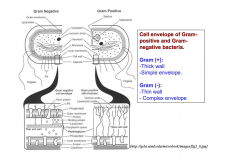
G+: cytoplasmic membrane, very thick peptidoglycan. Tend to be more heat resistant G-: cytoplasmic membrane, very thin peptidoglycan envelope but complex with teichoic acid. Tend to be more acid resistant
|
|
|
Nitrogeneous Bases of DNA and RNA |
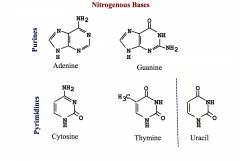
|
|
|
Enterobacteriaceae characteristics (general) |
- Gram- negative, rod-shaped -Motile by peritrichous flagella -Meosphiles (optimum between 23-35C) -Facultative anaerobes -Both respiratory and fermentative metabolism of carbs. -Reduce nitrate to nitrite (most species) -Catalase-positive (helps overcome H2O2) -Oxidase negative-alternative ETC -Ecology and host range: soil, water, and vegetation, human, animal and plant pathogens, common inhabitants in the GI tract
|
|
|
TCA Cycle Steps/End-products (diagram) |

|
|
|
Fermentation By-products? Diagram |
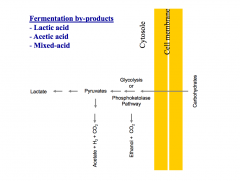
By-products: Lactic acid, acetic acid and mixed acid (Esp. Enterobacteriaceae) |
|
|
Enterobacteriaceae genera significant to food? |
- Citrobacter -Enterobacter -Erwinia -Escherichia -Hafnia -Klebsiella -Proteus -Salmonella -Shigella -Yersinia |
|
|
Coliforms |
-Indicators of fecal contamination water and food (according to the gov't) -Fecal vs non-fecal origins -Coliform genera: Citrobacter, Enterobacter, Escherichia, Klebsiella |
|
|
Characteristics of Pseudomonas spp. Morphology |
-Morphology: Gram-negative, rod shaped, motile by polar flagella (in liquid) -may secrete pigments: Pyoverdin (fluorescein) produced by P. fluorescens and P. aeruginosa. Pyocyanin by P. aeruginosa (detect on agar, food spoilage determinant) |
|
|
Pseudomonas spp. Biochemical and physiological characteristics |
-Catalase positive- AEROBIC RESPIRATION -Oxidase variable, usually positive -Obligate aerobe -Some strains can use nitrate as a final electron acceptor during respiration. -Mesophilic to psychrotrophic. -Utilize a wide range of organic substances -No growth factors required -Compete very efficiently for iron -Absence of fermentation, photosynthesis, and nitrogen fixation. -Not acidophiles -Catabolically diverse -Bioremediation |
|
|
Steps in biofilm formation |
1. Reversible attachment 2. Irreversible attachment-extracellular polysachharides 3. Maturation 4. Dispersion |
|
|
Significance of biofilms for food? |
1. Equipment contamination- when mechanical removal is difficult (pipes, drains etc..) 2. Continuous source of spoilage- one contaminated valve will continue to contaminate all products coming into contact 3. Difficult to remove by washing and sanitization- once film is formed cannot guarantee removal. |
|
|
Most common species of Pseudomonas that spoil food? |
P. fluorescens group (most common) P. fragi P. lundensis P. putida
Meat and poultry spoilage! (odor, color, slime) Dairy- produces heat stable lipases and proteases, spoil milk by causing bitterness, casein breakdown, and robiness due to production of slime and coagulation of proteins. Butter- Putrid smells (P. putrefaciens), rancid (FFA) from P. fragi or P. fluorescens, Skunk-like smell- P. mephitica, BLACK- P. nigrifaciens Vegetables- slime from pectin breakdown Fish and ground meat- sulfidy off smell (H2S) from cysteine breakdown |
|
|
Genera of lactic acid bacteria of importance in food? |
-Lactococcus -Leuconostoc -Streptococcus -Pediococcus -Lactobacillus |
|
|
Characteristics (general) of LAB? |
-Gram+ -Nonspore-forming -Anaerobic (or microaerophilic- don't need it but can tolerate it) -Catalase negative -Nutritionally fastidious (needs nutrients from the environment) -Cannot generate energy by respiration (incomplete TCA cycle and ETS) -Generate ATP by fermentation with lactic acid as major end product |
|
|
Homolactic vs Heterolactic fermentation? |
Homolactic fermentation: EMP (Embden-Meyerhof-Parnas) pathway glycolysis + lactate dehydrogenase. End products: Lactic acid and ATP. Examples: Lactococcus, S. thermophilus, Pediococcus, some Lactobacillus
Heterolactic fermentation: Phosphoketalase pathway. Under anaerobic conditions: get CO2, lactic acid, ethanol, ATP. Under aerobic conditions: CO2, lactic acid, acetic acid and ATP. *Heterolactic fermentation not that efficient- will use up CHOs in environment quickly. Examples: Leuconostoc, Oenococcus, some Lactobacillus |
|
|
Lactobacillus characteristics |
Morphology: Rods or chains CO2 from glucose: + or - Cardinal temp: Can be psychrotrophic all the way to thermophilic Species relevant to fermentation: L. bulgaricus Species relevant to spoilage: L. fermentum Species relevant to health: L. acidophilus, L. reuteri (probiotics) Comments: Diverse genus |
|
|
Lactococcus characteristics |
Morphology: Cocci CO2 from glucose: No Cardinal temp: Likes milder temperatures (10C-37C) mostly psychrotrophic Species relevant to fermentation: L. lactis Species relevant to spoilage: none Species relevant to health: none Comments: Lancefield Group N |
|
|
Streptococcus characteristics |
Morphology: Cocci, chains (always) CO2 from glucose: no Cardinal temp: Thermophilic Species relevant to fermentation: S. thermophilus Species relevant to spoilage: none Species relevant to health: S. pyogenes, S. pneumoniae, S. mutans **VERY BAD! Comments: Lancefield Group A, B and others |
|
|
Pediococcus characteristics |
Morphology: Cocci and tetrads (always) CO2 from glucose: No Cardinal temp: Can be psychrotrophic or thermophilic Species relevant to fermentation: P. acidilactici Species relevant to spoilage: none Species relevant to health: none Comments: High salt tolerance- good in fermentated meats (pepperoni) |
|
|
Leuconostoc characteristics |
Morphology: Cocci CO2 from glucose: YES Cardinal temp: Milder temperatures 10-37C (psychrotrophic/mesophilic) Species relevant to fermentation: L. mesenteroides Species relevant to spoilage: L. carnosum (grows on carcasses) Species relevant to health: None Comments: Vegetable fermentation (sauerkraut) |
|
|
Types of fermented foods and the LAB used |
Dairy (yogurt, cheese, sour cream)- ex: S. thermophilus Meat (fermented sausages)- ex: P. acidilactici Vegetables (pickles, kimchi etc) ex: Leuconostoc, Pediococcus, LAB |
|
|
Examples of LAB used as probiotics |
Lactobacillus reuteri, Lactobacillus acidophilus |
|
|
Antimicrobials made by LAB? |
-Bacteriocins made by LAB: nisin! -Also H2O2, acids (acetic, lactic) etc.. can be used as AMA in foods |
|
|
Hemolytic Serology Categories |
Alpha-hemolytic: green partial hydrolysis (Ex: Streptococcus pneumoniae, Streptococcus viridians) Beta-hemolytic: clear, complete hydrolysis (ex: Streptococcus pyogenes- Type A bacitracin sensitive; Streptococcus agalactiae- Type B bacitracin resistant) Gamma-hemolytic: No hemolysis- used in foods, non-pathogenic. Ex: Entococcus faecalis, E. faecium
|
|
|
Basic characteristics of bacterial spores |
-Dormancy and Longevity -Resistance to deleterious factors: resist factors that bacterial cells can not survive. Eg: heat (hot environment, boiling water), lack of water (arid environment), presence or absence of air (even aerobic spores don't need it), antimicrobial agents |
|
|
Whats the name for spore formation? |
Sporulation! It is a stage in the life-cycle of a spore-forming bacterium |
|
|
Spore Structure (diagram) |

|
|
|
Stages of sporulation in bacteria |
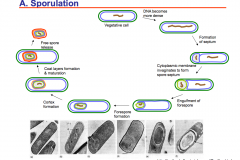
|
|
|
Spore transformation to Vegetative Cell (Germination) |
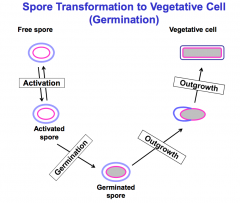
Activation: a treatment to facilitate the germination process, reversible- can be activated by sublethal heat, low pH, chemicals etc. *Must remove outer coats Germination: degradation events triggered by germinants (nutrients L-alanine, ribosides; non-nutrients: Ca-dipicolinic acid; enzymes: lysozymes; physical process; high hydrostatic pressure), irreversible, loss of heat resistance, release of dipicolinic acid, cortex hydrolysis, core hydration (loss of refractility- phase-bright to phase-dark); decrease in optical density Outgrowth- development of vegetative cell from a germinated spore- emergence from the spore coat, elongation of the emergent cell |
|
|
Factors in spore resistance |
1. Vegetative cell makeup and characteristics- optimum growth temperature of cell will yield same resistance in spore- thermophilic spores>spores of mesophiles>spores of psychtrophiles. More heat exposure increases resistance. 2. Spore structure |
|
|
Spore structure- Core SASP resistance |
Resistant to Dry heat, UV radiation, Desiccation and freezing |
|
|
Spore structure- Core dehydration resistance |
Resistant to Wet heat and hydrogen peroxide |
|
|
Spore structure- Core minerals resistance |
Resistant to dry heat, wet heat and hydrogen peroxide |
|
|
Spore structure- Spore Cortex resistance |
Resistant to wet heat, lytic enzymes, hydrogen peroxide. NOT resistant to UV radiation. |
|
|
Spore structure- Spore coats resistance |
Resistant to Lytic enzymes, and hydrogen peroxide. Not resistant to wet heat or UV radiation. |
|
|
Heat resistance in spores is a measure of what compared to the vegetative cell? |
Refers to the temperature at which the decimal reduction (killing by 90%) time of a heated suspension is 10 minutes. |
|
|
Control of spores- Ways to inactivate (sporicidal) |
1. Severe heat (retort) 2. Gamma radiation- heavy; spices use gamma radiation 3. Hydrogen peroxide (high concentration and heat): vapor (used with sterile packaging) 4. Ethylene oxide- in non-foods (disposable pipettes) 5. Chlorine 6. Ozone 7. Combination "hurdle process" |
|
|
Control of spores- Inhibition of germination and/or outgrowth (sporostatic) |
1. Bacteriocin: Nisin 2. Nitrite |
|
|
Bacillus cereus |
Mesophilic aerobe, facultative anaerobe. Importance in foods: food intoxication, cooked rice, pasta, meats, soups, salads, puddings. |
|
|
Bacillus subtilis |
Mesophilic aerobe, obligate aerobe. Spoilage: "ropy" bakery product; softening of pickles |
|
|
Alicyclobacillus spp. |
Thermophilic aerobe. Acidophile: growth at pH 2.5-5.5 (opt: 3.5-4). Optimum temp: 46-50C. In foods: flat sour spoilage, spoilage of fruit juices and iced teas |
|
|
Bacillus coagulans |
Thermophilic aerobe. Facultative anaerobe. Growth opt >50C. Aciduric: opt pH 6. In foods: flat sour spoilage, spoilage of canned tomato juice and other acid foods. |
|
|
Bacillus stearothermophilus |
Thermophilic aerobe. Facultative anaerobe. Growth at 40-70C (opt >60C). In foods: flat sour spoilage; spoilage of low acid canned vegetables. |
|
|
Clostridium sporogenes |
Mesophilic anaerobe. Putrefactive anaerobe. In foods: spoilage of canned vegetables (swelling and putrid odor). |
|
|
Proteolytic Clostridium botulinum |
Mesophilic anaerobe. Produce toxin types: A, B, F. Digests gelatin, milk and meat. In foods: Food intoxication, home-canned foods; foods subjected to faulty processing or temperature abuse. |
|
|
Non-proteolytic Clostridium botulinum |
Mesophilic anaerobe. Produce toxin types: B, E, F. Saccharolytic. Psychrotrophic. In foods: Food intoxication. Food implicated: fermented marine products, dried fish, vacuum packed fish. |
|
|
Clostridium perfringens |
Mesophilic anaerobe. Air-tolerant. Rapid growth. Stormy fermentation of lactose in milk. In foods: foodborne non-invasive infection. Food implicated: meat and poultry products. |
|
|
Clostridium tyrobutyricum |
Mesophilic anaerobe. Some strain produce toxin type E. In foods: gas formation ("late blowing") of cheeses. |
|
|
Clostridium thermosaccharolyticum |
Thermophilic anaerobe. Opt. growth 55-62C. In foods: spoiled canned vegetables |
|
|
Desulfotomaculum nigrificans |
Thermophilic anaerobe. Obligate thermophile: min growth temp at 43C or greater. In foods: Hydrogen sulfide spoilage of acid canned vegetables (blackened appearance and rotten egg odor). No swelling of can. |
|
|
General characteristics of Fungi |
-Eukaryotic, heterotrophic (saprophytes- dead matter or hypotrophic- parasites). -Strictly aerobic--> facultative anaerobic (can metabolize without it ex: yeasts). Relevance to foods: growth on surface, probably fungi. Cell wall contains chitin (like insects) and cellulose (like plants) or both. |
|
|
Morphology of Fungi |
Single-celled (eg yeast): generally larger than bacteria. Dimorphic (ex: Candida): unicellular or pseudohyphae Multicellular (eg: mold): thread-like strands called hyphae (collectively- mycelium). Septate or non-septate. Mushrooms- complex |
|
|
Mushroom structure |
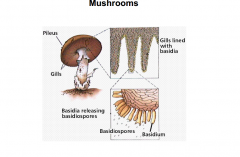
|
|
|
Morphology of foodborne fungi |
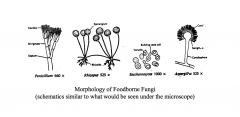
|
|
|
Propagation of fungi |
Binary fission: rare Budding: common in unicellular (eg: Saccharomyces cerevisiae). Elongation of hyphae (at tip): propagation Fragmentation of hyphae: each piece becomes a new colony Formation of spores: Asexual or sexual |
|
|
Characteristics of Chytridiomycota |
Septate hyphae: None Asexual sporulation: motile zoospores Sexual sporulation: oospores Comments: lower fungi |
|
|
Characteristics of Zygomycota |
Septate hyphae: Yes Asexual sporulation: Non-motile sporangiospores Sexual sporulation: Zygospores Comments: lower fungi, not xerophilic, not resistant to heat and chemicals, rare mycotoxin production |
|
|
Characteristics of Ascomycota |
Septate hyphae: Yes Asexual sporulation: Condiospores Sexual sporulation: Ascospore Comments: Higher fungi, mostly xerophilic, often resistant to heat and chemicals |
|
|
Characteristics of Basidiomycota |
Septate hyphae: Yes Asexual sporulation: Rare Sexual sporulation: Basidiospores Comments: Higher fungi, mushrooms, puffballs, rusts, jelly fungi. No significance to food spoilage |
|
|
Characteristics of Deuteromycota |
Septate hyphae: Yes Asexual sporulation: Conidiospores Sexual sporulation: None Comments: Higher fungi. Some are xerophilic, not resistant to heat, some resistant to chemicals, production of mycotoxin is common |
|
|
Asexual fungal spore types |
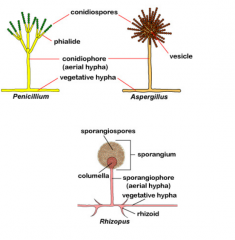
Conidia or conidiospores- Penicillum spp, Aspergillus spp. Sporangiospores: Rhizopus spp. |
|
|
Sexual Fungal Spores |
Zygospores: spore resulting from the fusion of haploid mating hyphae to produce a diploid zygospore. Eg: Rhizopus spp. Ascospores: Spores of different mating types in an ascus (pod). Eg: Saccharomyces spp. Basidiospores: Haploid spores formed on a fungal structure called a basidium. Eg: mushrooms. |
|
|
Formation of zygospores |

|
|
|
Formation of ascospores (formed in single cell fungi) |
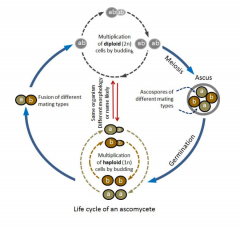
|
|
|
Formation of basidiospores |
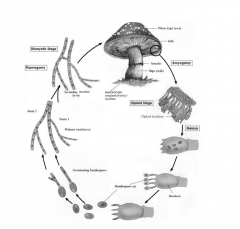
|
|
|
Beneficial fungi examples |
Yeast- fermentation Edible fungi- mushrooms, morels, truffles Cheese production (surface ripened) Decomposition in the biosphere- wood-rotting fungi Symbiosis between fungus and plant Produce antiobiotics- penicillin produced by Penicillum spps |
|
|
Detrimental/Pathogenic Fungi Examples |
Detrimental- spoilage Pathogenic- plant pathogens (eg: Irish potato famine; loss of chestnut trees); Human pathogens: A. Invasive: athletes foot, ringworm, Candidiasis. B. Toxigenic: mycotoxins |
|
|
Mucor characteristics |
Identifying characteristics: nonseptate hyphae, smooth non-striated sporangiospores, produce no rhizoids. Important properties in food spoilage: Grow on refrigerated meat ("whiskers"). Black spots on frozen mutton, Very common on bread. |
|
|
Rhizopus characteristics |
Identifying characteristics: Nonseptate hyphae, umbrella-shaped columellae, large sporangiospore with striated wall. Dark sporangia containing dark to pale spores. Important properties in food spoilage: Bread mold, watery soft rot of fruits, black spot on beed, bacon, frozen mutton. |
|
|
Aspergillus characteristics |
Identifying characteristics: Black, brownish black, purple brown conidiospores. Yellow to green conidia. Dark sclerotia. Important properties in food spoilage: A. niger: black rot on fruits and vegetables. Yellow, green to black on large number of foods. |
|
|
Penicillium characteristics |
Identifying characteristics: P. digitarum: yellow green conidia, P. italicum & P. expansum: blue-green conidia, P. camemberti: gray conidia. Important properties in food spoilage: Blue/green rots of citrus fruits. Soft rots of apple, pear, peaches. |
|
|
Geotrichum characteristics |
Identifying characteristics: Arthroconidia formation, White colonies- colorless conidia. Important properties in food spoilage: Machinery mold, soft rot of citrus fruits, peaches. Common in dairy products. Some have strong odors. |
|
|
Fusarium characteristics |
Identifying characteristics: Cottony, pink, red, purple, brown colonies. Sickle shaped conidia. Extensive mycelium, colorless conidia. Important properties in food spoilage: Soft rot of rigs, brown rot of citrus fruits/pineapples, bacon and refrigerated meat spoilage and pickle softening. |
|
|
Saccharomyces characteristics |
Identifying characteristics: Multilateral budding, spherical spores, white or cream colonies, typical yeasty odor Important properties in food spoilage: S. cerevisiae: ubiquitous contaminant, sometimes fermentative spoilage of soft drinks, some strains are preservative resistant. |
|
|
Zygosaccharomyces characteristics |
Identifying characteristics: multilateral budding, "dumbbell" shaped asci, 1-4 ascospores/ascus, Bean-shaped ascospores, strong fermenter of sugars! Important properties in food spoilage: Z. bailii: highly resistant to preservatives, xerophile, capable of growth at aw: 0.8, pH 1.8, heat resistant, ascospores, spoil tomato sauce, mayonnaise, salad dressing, soft drinks, fruit juices etc. Z. rouxii: grow at aw: 0.62 |
|
|
Candida characteristics |
Identifying characteristics: Cells are spherical, cylindrical, ovoid, or elongate. Pseudomycelium formation. Important properties in food spoilage: Common yeasts in fresh ground beef and poultry. C. krusei: preservative resistant, form films on pickles, olives sauces. C. parapsilosis: spoil cheese, margarine, dairy and fruit products |
|
|
Most problemative species of fruit concentrates (etc), ketchup, salad dressings, relishes.. etc. |
Zygosaccharomyces bailii and Zygosaccharomyces rouxii. Why?? Can grow at low water activity, grows over wide range of solute contents. Resistance to preservatives! |
|
|
Behavior of M/O refers to what? |
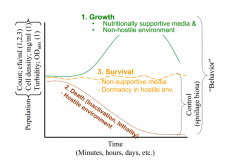
Their growth, survival and death in foods |
|
|
Microbial Growth Requirements |
-Water -Nutritional needs: carbon source, nitrogen source, growth factors/vitamins/minerals -Environment: temperature, oxygen presence or absence, pH -TIME |
|
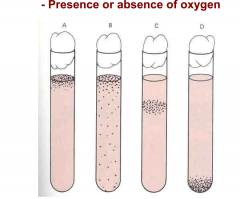
|
A. Strict Aerobe- Ex: Pseudomonas B. Facultative Anaerobe- Ex: Escherichia coli C. Micro-aeorphilic or Aerotolerant Anaerobes- Ex: Lactic acid bacteria; Leuconostoc D. Strict Anaerobe- Ex: Clostridium botulinum |
|
|
Facultative anaerobes will grow better under which oxygen condition? |
Grow faster in the presence of oxygen! |
|
|
Categories Based on Optimum Growth Temp |
Psychrophiles- love low temperatures (0-20C), grow in the fridge Psychrotrophs- huge range of temperatures: 5-40C Mesophiles- 20-40C, mostly 35-37C Thermophiles- 45-75C |
|
|
Microbial categories based on acid environment |
Acidophiles- fungi: Zygosaccharomyces Acid-tolerant: LAB; grow better without acidic environment though Acid sensitive: Pseudomonas, Clostridium **Fungi tend to tolerate acid better than bacteria in general |
|
|
You leave two foods out on the counter- one gains weight and the other loses weight. In regards to water activity- which had a lower initial aw? Which is more susceptible to M/O growth? Why? |
The food that gained weight had a lower water activity because its absorbing water vapor from the air; whereas the one that was losing weight had a relatively higher aw- was losing water to the environment (more susceptible to M/O growth- more free water) |
|
|
What are intermediate moisture foods? |
A food product that has a water activity below that which is required for the growth of m/o; or a food containing unavailable water. Characterized as an aw: 0.65-0.90 and general soft texture. |
|
|
Minimum aw for M/O growth |
Bacteria: minimum 0.9 (eg: Clostridium botulinum min is 0.94) Exception: Staphylococcus aureus- 0.85 Most spoilage molds: minimum: 0.8 Most spoilage yeasts: minimum: 0.85. Exception some Zygosaccharomyces spp. |
|
|
In regards to food components- bloating of solid foods or container swelling is implicating what type of breakdown? |
Degradation of CHOs with CO2 production/other gas |
|
|
In regards to food components- slime is implicating what type of breakdown? |
Breakdown of complex CHOs (polymerization)- pectin is example. |
|
|
In regards to food components- texture loss is often implicating what type of breakdown? What about rancidity? |
Proteolysis (by proteinases and peptidases). Rancidity= lipolysis by lipases. |
|
|
Parmesan cheese owes its sharp flavor to what |
Lipolysis by M/O |
|
|
Types of food packaging techniques for M/O control |
Air and spoilage- if it needs O2, make anaerobic environment. Surface vs Bulk- air in headspace; differential spoilage Food packaging: Headspace (remove oxygen), Canning and Vacuum packaging (no air in headspace or no headspace); Modified Atmospheric Pressure (if you can't get rid of O2- then modify amounts)
|
|
|
Low-acid foods were categorized by the gov't in regards to what M/O? What pH were they based on? |
Clostridium botulinum- pH 4.6. Low-acid foods are at a pH between 4.6-5.3 (cheeses) and greater than 5.3- bread, fish, meat, beans, milk, vegetables, egg whites; pH 7.6-9.5: lots of problems! |
|
|
What does incidence refer to? |
How M/O got into food. Unintentional (contamination): What is the source and point of entry into food? What is the level of contamination? Intentional: intentional inoculation of microbiota into foods (starter cultures or probiotics) |
|
|
What are the points of entry of contaminant along the food chain? |
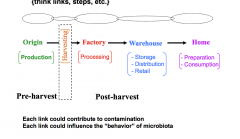
|
|
|
Consequences of M/O contamination depend on what? |
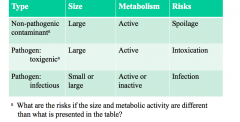
-Types of contaminating M/O -Size of contaminant (eg: cfu/g or ml) -Metabolic activity |
|
|
What does thermoduric mean? |
Tolerates pasteurization temperatures, may find in pasteurized foods. Ex: Some Bacillus spores (B. coagulans); some Clostridium spores (C. putrefaciens); Lactobacillus viridescens; some fungal spores |
|
|
Food spoilage during growth of small inocula (effect of cfu/g on likelihood of spoilage) |
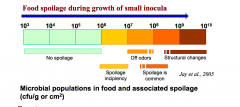
Caveats: in conjunction with numbers (population count), spoilage depends on type of M/O and their metabolic activity. Signs of spoilage in milk may appear sooner than they do in other foods. 10^5 cfu/g- start worrying, can hit spoilage population very quickly |
|
|
Dairy cattle breeds? Which produce dairy products/milk? |
Holstein-Friesian: main type for milk Brown Swiss Guernsey Ayrshire Jersey: golden milk color; fat contains carotene; cheddar cheese use to come from them Milking shorthorn
|
|
|
Definition of milk |
A fluid secreted by the mammary glands of females for the nourishment of their young; cow's milk used as a food source for humans. |
|
|
What pre-harvest factors affect milk microbiota? |
Production practices- is milk collected indoors? Increased chance of contaminants from environment. Animals activities: diet/exercise.. Animals health |
|
|
Harvesting Raw milk |
Preparing cow for milk- clean the udder prior to milking in milking parlor. Milking- hand milking increases risk of contaminants vs milking machines Storage on the farm- very important; MUST be refrigerated! Pick up frequency- daily (ideal); otherwise increased M/O growth |
|
|
Entry point of contamination in milk (of the udder) |
Contamination outside the udder can contaminate once in contact with milk from teat cistern. Teat cistern can get contaminated too. ** VERY LITTLE contaminants in raw milk of healthy cows |
|
|
Raw Milk Microbiota Sources |
Cows Udder: Foremilk vs final milk: Micrococcus spp. and Staphylococcus albus- Washing and disinfection. Cow's health status: particularly mastitis- Streptococcus agalactiae, Staphylococus aureus, Escherichia coli, Corynebacterium, Pseudomonas aeruginosa, Klebsiella. Impacts milk biota. Impacts yogurt and cheese industry. Utensils/Milking machine: general cleanliness and sanitation. Milk stones made, porous, harbors bacteria. Environment in milking parlor: proximity to maure piles, silos etc. Airborne bacteria of soil sources. Trucks- ex: ice-cream mix outbreak |
|
|
Raw Milk Microbiota Profile |
Total counts: Aseptically draw milk- 5x10^2-1x10^3 (mostly micrococci) Milking machine- 1x10^3-1x10^4 Bulk-milk tank- 1x10^4-1x10^5 (mostly psychrotrophs) |
|
|
Genera that may be present in raw milk |
Psychrotrophs: Pseudomonas Achromobacter Flavobacterium Bacillus Additional biota: Coliforms Enterococcus Lactococcus Leuconostoc Lactobacillus Propionibacterium |
|
|
Milk as a spoilage medium |
Milk compositions and M/o requirements- supports the most fastidious microorganisms (eg: LAB). Milk is 87% water, 4.9% lactose, 3.9% fat, 3.5% protein (casein mainly), 0.7% ash (salt). Has water and fat soluble vitamins. pH ~6.5 and a titratable acid level of 0.17. |
|
|
Spoilage before processing of milk causes |
-Heavily contaminated environment (equipment etc) -Temperature abuse -Lengthy refrigerated storage |
|
|
Main spoilage M/O in milk |
Psychrotrophs Bacilli and Pseudomonas Proteolytic and lipolytic bacteria: products yield, flavor defects (cardboard taste, oxidized) Alcaligenes spp: gram negative, psychrotroph, produces capsules- causes ropiness defect: milk tastes sweet and appears ropy (stringy) in texture. |
|
|
Animal Source Pathogens in milk |
Mycobacterium bovis (tuberculosis in children) M. tuberculosis (tuberculosis) M. paratuberculosis (Johne's disease in ruminants; Crohn's disease in humans) Brucella spp- Infectious abortion in animals and brucellosis or undulant fever in humans Coxiella burnetti- Q fever in humans LIsteria monocytogenes: listeriosis Escherichia coli O157:H7: gastroenteritis; hemolytic uremic syndrome Salmonella spp: gastroenteritis; typhoid fever Staphylococcus aureus: Intoxication
|
|
|
Human Source Pathogens in milk |
Streptococcus pyogenes: scarlet fever/sore throat Salmonella enterica serovar Typhi: Typhoid fever Shigella spp: Shigellosis Corynebacterium spp: Diphtheria |
|
|
Environment Source Pathogens in milk |
Bacillus cereus: intoxication Bacillus anthracis: anthrax Clostridium pefringens: Gastroenteritis Clostridium botulinum: Botulism Listeria monocytogenes: Listerosis |
|
|
Post-harvest Processing and MO Quality in Milk |
Raw milk- unprocessed Pasteurized milk- mildly processed UHT milk- highly processed Yogurt, buttermilk, sour-cream, cheese- mild processed and fermented Concentrated, condensed, powdered- milk to high processing |

